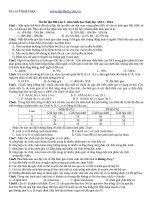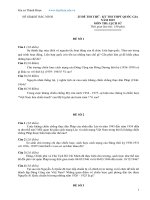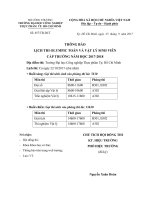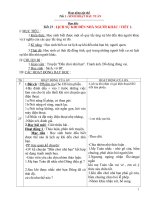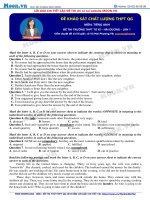Cs224W 2018 25
Bạn đang xem bản rút gọn của tài liệu. Xem và tải ngay bản đầy đủ của tài liệu tại đây (6.33 MB, 10 trang )
Project
Report:
On Representation Power of Character
Feature Extraction and Inferences
Github Repo: https: //github. com/annazhu1996719/C5224W-project.git
Zhining Zhu
Kuangcong Liu
Zhen Qin
1. Introduction
The complex structures of social networks inherently
embed rich information, and thus social graphs have
always been serving as a starting point for feature extractions. With representative features extracted from
social networks, Machine Learning will act as a powerful tool in tasks ranging from regression and classification, to clustering and others. Our project will
focus on combining feature extractions on social networks with Machine Learning. Our goal is to analyze
methods of extracting representative features for social networks, and to understand the usefulness of the
extracted features in making further inferences on the
networks.
In order to accomplish this goal, we will use Character
Movie Network, which is a social graph on relationships between characters in movies, as a representative
of small scale social networks. And we have defined
two specific tasks to evaluate the usefulness of network features in realistic settings, which is to predict
IMDB movie ratings and genre from character movie
networks. Furthermore, we target to gain insights on
the relative significance of features extracted by looking into the results and weights of predictions made
from Machine Learning methods.
2. Relevant
Prior Work
There are several relevant papers analyzing feature extraction from different perspectives. One of them is
Mining and Modeling Character Networks (3), which
explores the usefulness of hand-picked basic graph features such as clustering coefficient, modularity, pagerank, motifs and cliques. Similar to their experiments
which use these features to predict if a character network is real or fake, our experiments also utilizes the
same features they are suggesting for prediction. On
the other hand, Representation Learning on Graphs:
Methods and Applications (7) emphasizes more on re-
cent research progress on automating
the process
of
Network
CECILIA4 @STANFORD.EDU
feature generation by an encoder-decoder framework
that tightly connects with Machine Learning. Inspired
by their idea of node to vector representation, we developed our algorithm of complete graph to vector
representation. In addition, Exploiting character net-
works for movie summarization
(5) provides us with
one important feature of the network by analyzing the
score of each character, each of which contains information on several properties of the network such as
degrees and distances. Their technique of identifying
the main character provides us approaches to extract
features related to main character nodes.
3. Dataset
In this project, we use two datasets:
1.
Moviegalaxies
(http: //moviegalazies. com/):
A collection of around 800 character networks extracted from movie scripts. Each character network is
a weighted undirected graph with weights representing the interactions and relationships between pairs
of characters. Each movie is also associated with its
IMDB Id, through which we can join the character
networks dataset with the IMDB movie dataset
2. IMDB Movie Dataset: The IMDB Movies Dataset
contains information about 14,762 movies. It contains
useful movie features including IMDB-rating, religion,
duration, director, language, genres and so on. The
IMDB-rating and genre are what we will target to predict in our experiments.
3.1. Data
Preprocessing
1.
Moviegalaxies:
Each Character Movie Network
comes in as an xml file with information on nodes,
edges, and edge weights. To make use of them, we
first scrap all the useful information into csv files, and
then load each network as two directed weighted net-
works(PNEANet object in SNAP) into python. A subtlety here is that ideally we would
like to use undi-
Project
Report:
rected weighted
However, SNAP
weighted graphs,
compromise, for
a Gundir
On
Representation
Power
of Character
networks to best represent the data.
only supports either undirected unor directed weighted networks. As a
each movie m, we created a Ga, and
PNEANet
in the following way:
Gar: For each connection between character u and v
in movie m, create one weighted edge of weight w from
u to v, and one weighted edge of weight w from v to
u, where w is the weight of the connection between
character u and v.
Gunair. For each connection between character u and
v in movie m, create a weighted edge of weight w from
u to v, where w is the weight of the connection between
character u and v.
When computing different network properties and
statistics, we are able to use whatever more convenient, Gair or Gunair- For example, Gunair is more
suitable in computing degree of the network, while
Gar is more appropriate in computing the diameters
of the network.
2. IMDB Movie Dataset: Based on the IMDB ID of
each character network’s movie meta-data, we query
out all 659 movies that have character graph information.
Then factorize non-numerical features into
integers. Finally, join the selected IMDB Dataset and
graph properties with IMDB ID as index.
For regression experiment, our prediction target is
IMDB-rating. IMDB-rating is a decimal ranging from
0 to 10 with step size 0.1. From the total 659 movies,
the maximum rating is 9.3 and the minimum rating is
4.3.
For classification experiment, out prediction target is
movie genre. A movie can have arbitrary number of
genres. In IMDB dataset there are 27 total genres, out
of which we choose 12 that have more than 3% of the
659 movies under the genre. Then encode the genre
in to a vector of 0 and 1’s, with 1 representing the
movie is in this genre and 0 otherwise. In Table 1 we
represent the genre count distribution of 659 movies.
Genre
Count |
0
1
2
3
Movie Count | 2 | 84 | 229 | 344
Network
NETWORK
Feature
PROPERTY
Extraction
and
NETWORK
Inferences
USED
FORMULA
num_characters
num_edges_unweighted
Gundir
Gundir
weighted_degree_sum
Gunair
weighted_degre_avg
Gundir
Mt
chustering_coe ƒ Ƒicients
Gundir
rat aes
density
maz_shortest_path
Gundir
Gair
Ta
=
Tn44;7c{1...
avg-shortest_path
Gair
weighted_degree_max
Table
d; :=
WwW; :=
€; :=
Pij =
Gundir
|V|
|E|
es dj
múi
ye
|E
Petie(.
2. BASIC NETWORK PROPERTIES
OUT DEGREE OF THE I-TH NODE
WEIGHT OF I-TH EDGE
NUM OF EDGES BETWEEN NEIGHBORS OF NODE I
LENGTH OF SHORTEST PATH BETWEEN NODE I & J
4.1. Graph
Representations
We mainly experiment with five types of network features in representing the Movie Character Networks.
We will describe below how to extract each types of the
features in details, and summarize the initial findings
and statistics.
4.1.1.
BAstc
NETWORK
PROPERTIES
The basic properties we studied on include number of
characters, number of edges, total weighted degrees,
max weighted degree, average weighted degrees, clustering coefficient, density, diameter (max length of
shortest paths), and average length of shortest paths.
The formulas are specified in Table 2.
See the distribution of basic network properties over
the 773 Character Movie Networks in Figure 1.
We have also attempted to calculate the number of
connected components and the size of the largest connected component for each Movie Character Network.
However, it turns out that there is only one connected
component for each network, and thus the size of the
largest connected components is just the total number
of nodes. As a result, we discard these two features to
avoid highly correlated features.
Table 1. Histogram of genre count in our dataset
4.1.2.
4. Approaches
Findings
and Preliminary
In high level, our approach is to first find an abundant
set of features to represent the networks, and then pass
them as inputs to machine learning frameworks.
MOTIF
d;
COUNTS
Motifs are potentially very useful in interpreting Character Movie Networks since they embed the relationship between characters. Therefore, we also look at
the counts of size 3 and 4 motifs in each network. Because Character Movie Networks are undirected, we
limit our study to undirected version of motifs (Figure
dị
ZL ae
On
Representation
Power
of Character
distribution of number of characters in movie character networks _distritytion of number of edges(unweighted) in movie character networks
300
z0
200
150
100
số
10
`
50
°0
2
20
0
2
oo
distribute
400
350
xo
=
200
150
100
sỹ
10
200
300
a0
7ỦU
f average of clustering coefficients in movie character networks
250
9
°
000
distribution of density (weighted) of movie character networks
400
350
300
z0
200
150
100
06L
04L
150
005
010
015
020
025
030
035
040
045
xơ distribution of the diameter of movie character networks
and
Inferences
=
|
\
|
'
|
|
08+
distribution of ayerage of weighted degrees for each network in movie character net
Extraction
Boxp|ot for proportion of each size 3 and 4 motifs counts(undirected)
+
°0
0
Feature
H+
200
Network
tị
+
+
c=~~-l#*
Report:
— PH
HH
Project
g4
rø gt
Motf
Motif2
Motif4
Motif3
MotifS
Motif6
Motif?
Mobf8
250
Figure 3. Distribution of proportion of each motif over the
773 networks
200
150
100
50
°
°
(a) K-core Features
Figure 1. distribution of the basic network properties over
the 773 Character Movie Networks
2).
wy I
IS
PINT
Motfli
ˆ
e
...'
eo—-e
Motif2
e—e
Motif5
e
Motif3
ˆ
A k-core of a graph G is a maximal subgraph of G
in which all vertices have degree at least k, and it
represents the clustering structure of the graph. In
our case, the number of k-core of a movie character
network means the number of closely-connected
small communities of characters with appropriate
grouping criteria. In other words, number of kcore can be interpreted as the number of ways we
can group the characters into sub-communities in
which everyone has interactions with at least k
other people.
For prediction purposes,
we extract
the number
of k-cores for k € {1,2,3,4,5} for each Character
e—e
Motif6
Movie Network as features.
(b) Modularity
Modularity is a measure of how well a network is
partitioned into communities. Formally,
Motif 7
Motif 8
Figure 2. Undirected motifs of size 3 and size 4
The distribution of proportion of each motif over the
networks is shown in the boxplot (Figure 3). it is no-
ticeable that Motif 3 occurs most frequently, which implies that having central characters that connect with a
lot of other characters is a universal pattern in movies.
4.1.3.
REPRESENTING
CLUSTERING
AND
COMMUNITIES
Since we are experimenting with social networks, the
community and clustering structures are worth extensive study of. We mainly use the following two methods to represent the microstructure:
9(G,8)=
3323 (4u —
%Cs jEs
We first use two community detection algorithms
(Girvan-Newman
algorithm(4)
and
ClausetNewman-Moore algorithm(1)) to partition graphs
into communities, and then compute the modularities of the resulting communities from two
community detection techniques respectively.
In order to get an intuitive understanding of how
community detection algorithms are performing,
as well as what graphs have high modularities, we
choose two typical Character Movie Networks to
make some visualizations. We choose network 3
and 5, of which one has high modularity and the
Project
Report:
On
Representation
other has low modularity.
Power
of Character
Table 3 displays the
modularities of network 3 and network 5 after performing the two community detection algorithms,
and Figure 4 visualizes the original network structures of network 3 and network 5. We also use
Network
Feature
Extraction
and
Inferences
(a) Identify the Main Character
To find the main character,
centrality measures.
we
combine
several
In details, for each Movie Character Network, we
colors of nodes to label the communities detected
first compute the Closeness Centrality, Between-
though the two algorithms divide different nodes
node,
whose
based
on each measure.
by the two algorithms respectively. Obviously, alto communities, there is a clear pattering of clustering
in network
both
3 with
algorithms,
while
it is hard to find any clearly-divided communities
from network 5. As a result, detecting communi-
ties in network 5 results in a low and even negative
modularity.
ness Centrality, and Page Rank score for each
After that, with the out-
put of the above three measures, we define the
main character of the network to be the node that
is identified as “central” most often, and break ties
randomly.
Formula
Centrality
Graph of network 5
Graph of network 3
đ
|
â
(
1
Giga) = SSGea)
Closeness
-
he
)
.
in
formal definitions are elaborated
Table 4. Then, we select the top 2 central nodes
Betweenness
Cpet(%) =
petit
2H
ơ„;: num of shortest path from y to Z
x
Øyz(z):
Út SP
num oŸ such paths pass through x
Page Rank | - or) =3 2.
Table 4. Formal Definition of Centrality Measures
Communities of network 3 using CNM
9: ,o,
mi
Communities of network 5 using CNM
KP
ẠC
7
L/
0:
©
~
Figure 4. Community
Network
Detection
Girvan-Newman
CNM
Again, Figure 5 visualizes the central nodes in network 3 and network 5 with the three centrality
measures. In network 3, all three centrality measures find the same two nodes as the central nodes,
so each central node is selected for exactly three
times. Therefore, we break tie randomly and define node 8691 as the “main character”. In network 5, however, all three measures regard node
22830 along with a different node as the top 2 central nodes, so we pick node 22830 as the “main
character” because it is the only overlap among
three groups of central nodes.
Central nodes ——
Central nodes in network 5
z®:
3
0.47261204
5
-0.005
Table 3. Modularities of network
community detection algorithms
4.1.4.
0.47261204
0.16
3 and
5 using
different
For each character network, we extract the egonet feainvolve two steps:
â
'đ
EGONET
tures of the main character.
â
The specific algorithm
)
Mice
io
l
â
F
zđ-
đ:
Figure 5. Central Characters: blue nodes are central nodes
found by the three centrality measures (may have overlap-
pings); green node is the “main character” following our
defmition
Project
Report:
On
Representation
Power
of Character
When calculating the Egonet features, we combine
basic features with recursive features of the main
character to obtain more comprehensive structural
information.
For each node 7, basic features are the degree of
node i, the number of edges in the egonet of node
¡¿ and the number of edges between node 2’s egonet
and the rest of the graph, as V,;’ (0) shown below.
Recursive features concatenate each node’s basic
features with the mean and sum of their neighbors
features, and we denote it as VX. We repeat this
process for twice and get ve) € R?", to generate
more information about this network. We select
the vectors of our two main characters as parts of
out features of the whole graph.
=
[d. Ui;
out;]
`...
1
TNO
4.1.5.
NETWORK
jEN(i)
Vi De VI
JEN (i)
EMBEDDINGS
Grover et al (2) proposed a method to represent
each node with a low-dimensional vectors of features that maximize the likelihood of maintaining
network properties. If two nodes have similar network neighborhoods, then their vector representations should also be close.
After exploring all the character networks, we find
out there is only one connected component in
each network and the average number of nodes
is around 30, which means our networks are relatively small. Then it is more intuitive to learn
more about the local features rather than the
global features of our networks.
Therefore, we choose the return parameter p = 0.1
which gives high probability in random walk for
each node to return back to the previous node.
Also select the In-out parameter g = 1. This will
be likely to the Breadth First Search method and
generate more helpful information about neighborhood of each node.
For each network, after getting the vector representations of each node, we simply calculate the
sum and average of all the node embeddings, and
then add those result vectors to our final feature
representation of each graph.
(AWE-FB)
Walk
Extraction
Embedding
and
Inferences
(6) also proposes
insightful method for graph embedding, which is
able to reconstruct graph information as a whole.
There are two approaches to embedding anonymous walk, the feature-based and the data-driven
embeddings.
AWE-FB embedding of a graph G is a vector, with
the size of all possible anonymous walks of some
length we choose. i-th element in the vector is the
probability of i-th anonymous walk a; on graph G:
V = [p(a1), p(a2), -.-, p(an)}
When the network is large or the length of anonymous walk is long, we couldn’t find all possible
anonymous walks, and therefore they use a MonteCarlo sampling method to approximate the true
distribution.
Under the situation of Character
Network, we choose anonymous walk length of 7
and sampling 10000 examples for each graph.
Anonymous
Walk
(AWE-DD)
Embedding
Data-Driven
Anonymous Walk Embeddings (6) proposes AWE-
(a) Node2Vec
(b) Anonymous
Feature
Anonymous Walk Embeddings
(b) Compute the Egonet features
A
Network
Feature-Based
DD method as a solution to the case when a
network has sparse feature-based vector.
This
method is really similar to the method of finding representation vectors for paragraph in a text
document.
For
DD
each
(6)
of random
T1,T2,...,Tk.
mous
node
first
walks
u
samples
in
a
graph
user-specified
G,
AWE-
& number
walks starting from wu, such as
Find the corresponding anonyrepresentationa,,da2,...,a,
and
se-
lect a; as target anonymous walk.
Then calculate the probability of that target anonymous
walk given the rest anonymous walk and the
representation vector of this graph d, which is
p(a;|ai, ..-, @i—1, @i41,---,@~,d). Try to maximize
this probability for all nodes in all graphs by finding best representation of anonymous walks for
all graphs and best representation vector of each
graph.
Compare node2vec, AWE-DD
and AWE-FB
Figure 6 shows us the similarities between second
network and other networks. The similarity is calculated by distance between the vector representations of networks. The black edges indicate edge
with weight more than 1 and the blue dashed edges
indicate weight less or equal to 1.
In node2vec algorithm, Network 832 has the highest similarity with Network 2, while Network 719
Project
Report:
On
Representation
Power
of Character
Graph of network 2
eô
â
â
Network
Feature
Extraction
Algorithms
â
and
Inferences
Kendalls 7 | Spearmans p
node2vec, AWE-DD
0.01
node2vec, AWE-FB
-0.028
AWE-DD, AWE-FB
-0.026
0.016
-0.041
-0.039
Table 5. Rank Correlation of three algorithms
Node2Vec:
Graph of network 719
After calculate the similarities rank of all networks
with Network 2 by using these three algorithms,
we could calculate the rank correlation by 2 methods, Kendall’s Tau and Spearman’s Rho. The results are shown in Table 5. From this table, we
could see that the correlation of rank vectors between algorithms are really low and there are even
negative correlations, which means that each algorithm predicts similarities with Network 2 in quite
different ways, and the main cause for this problem is probably lack of data.
4.2.
Predictions
4.2.1.
AWE-FB:
Graph of network 837
AWE-FB:
Graph of network 814
has lowest similarity. If we use AWE-DD method,
Network 749 has the highest similarity with Network 2, while Network 696 has lowest similarity.
In AWE-FB method, Network 837 has the highest
similarity with Network 2, while Network 814 has
lowest similarity.
From this figure, we could see that node2vec and
AWE-DD seem to perform better than AWE-FB
because Network 2 have two relative center nodes
with high weights
(black edges),
which is simi-
lar to the structure of network 832 and network
749, while Network 837 seems to have many cen-
ter nodes with high weights (black edges).
VALIDATION
Due to limited available data, we use k-fold cross validation for evaluation in all prediction tasks.
Randomly divide our training data into 11 equally sized
folds, each with 60 graphs, expect last fold with 59.
For each iteration, use one of the fold as test set and
10 other folds to train the model. Then average the
evaluation result, over 11 iteration as final evaluation.
4.2.2.
Figure 6. Graphs of Network2, and the most and the
least similar networks with Network2 calculated under
node2vec, AWE-DD and AWE-FB algorithms
CROSS
GENRE
CLASSIFICATION
Since there are 12 different genres, and each movie can
have multiple genres, we need to predict 12 different
classification tasks. We use the multi-label classification method to predict each genre one by one and output a prediction vector with 12 dimensions. Each element Ypreaict, € {0,1} represents whether this movie
is in i-th genre.
We define two metrics for genre classification evaluation, precision and recall. Precision is the total number of true positives divide the sum of true positives
and false positives. Recall is the total number of true
positives divide the sum of true positives and false negatives. To be more specific, assume Ypreaict, iS Our predicted genre label for ith graph and Ytrue, is its true
label:
Precision =
Recall =
di LH Ypreaict, = 1 and ytrue, = 1}
33; 1{Đpredice, = 1}
1}
3); 1{Øprediet, = l and yYrue, =
31; 1{true, = 1}
Project
Report:
On
Representation
Power
of Character
1. Support Vector Machine (SVM) use hinge loss to
minimize the distance to margin. The slack variable €,, allows some instances to fall of margin but
penalizes them. In addition, with kernels, SVM
maps the inputs into a higher dimensional feature
space. In our experiment we use Gaussian kernels.
SVM has objective:
„1
=
min slltellB+Œ 3 ›&¡
i=1,
——
Precision
0754
0.70 7 ——
Anonymous walk prob
Motif Count
¬
2
¬
0
2
Log C for SVM
¬
0
Log C for SVM
REGRESSION
We use mean square error(MSE) to evaluate regression
tasks on all iterations to predict the final test set. More
specifically, we use the following regression methods:
014 | ——
——
0.12 | ——
—
__
0.08 | ——
——
1. Lasso Regression combines least square regression
loss with LZ; norm regularization on the weights.
Since LZ; norm push non-relevant features’ weights
to 0. Lasso regression is helpful for subset selection. It’s objective is:
min|JsøX — Y llỗ+elltl|i
2. Support
Central node egonet
Anonymous walk
—— Graph embedding with sum
Graph embedding with average
—— Imdb property
-4
Recall
RATING
Inferences
—— Basic properties & Modularity & K-core
085 | ——
non linpercepand apweight
and
We perform classification on 7 different set of features
mentioned previously, and compare their recall and
precision. We find that there is trade-off between precision and recall while tuning the hyper-parameters.
For example, Figure 7 represents how precision and
recall change while sweeping different values of C, the
penalty term for SVM.
& 20
ear classifier with weight and bias, and a
ear output activation function. We use a
tron with D2 regularization penalty term
ply stochastic gradient descent to update
and bias.
Extraction
5.1. Classification
0.90
2. Single layer neural network (Perceptron) is a lin-
Feature
5. Results and Analysis
s.t.Vi, yi(wa; +b) > 1- &;
4.2.3.
Network
Vector Machine
Regression(SVR)
the same principles as the SVM
uses
for classification.
In the case of regression, the margin (e€) is set in
approximation to the SVM, with slack variables
€, and €* for each point as soft margin. More
specifically, the optimization problem for SVR is:
1
min sltelö+Œ À
“
.
(+7)
i=l
s.t. Vi, ys(wa; +b) <€+ &;
(0z; +b) —ụ
&¡,&7 > 0
In our prediction we use
where parameter w can
as a linear combination
tions using the equation.
can easily visualize the
after training completes.
SVR with linear kernels,
be completely described
of the training observaWith linear kernel, we
weights for each feature
006
Basic properties & Modularity & K-core
Central node egonet
Anonymous walk
Graph embedding with sum
Graph embedding with average
Imdb property
Anonymous walk prob
Motif Count
-4
4
Figure 7. Precision & Recall in SVM
Upon tuning SVM for each feature set, we list out the
precision and recall for the SVM with the best hyperparameters in Table 6. We find that although IMDB
features set achieves good precision, the model is very
conservative in predicting positive values, and therefore the recall is unusually low. On the other hand, two
sets of graph features achieve reasonable precision and
recall rates. One is “basic network property, modularity, and number of nodes”, and the other is “egonet of
central nodes” .
| Features
| Precision
Recall |
Basic,Modularity,K-core
Egonet of central node
0.580669 | 0.136838
0.608169 | 0.125977
Node2Vec sum embedding
Node2Vec mean embedding
0.532468 | 0.194945
0.513196 | 0.203783
Anonymous walk embedding || 0.528106 | 0.183756
IMDB features
0.84047 | 0.081382
Anonymous walk probability || 0.540545 | 0.187217
Motif count
Table 6. SVM
0.517879 | 0.189929
classification on different features
Project
Report:
On
Representation
Power
of Character
Similarly, we present the best Perceptron classification
results in Table 7. Overall, Perceptron classifier performs worse than SVM classifier. This is because perceptron is a linear classifier and has a weaker representation power than SVM. What’s interesting is that on
motif feature set, perceptron achieves pretty high precision. This might imply that local structural features
are linearly separable in genre classification problem.
Network
Negative MSE
~0 85
-0.95
Negative MSE
Basic,Modularity,K-core
0.576271 |
Egonet of central node
0.636587 |
Anonymous walk embedding || 0.319654 |
Node2Vec sum embedding
0.468644 |
Node2Vec mean embedding
0.280620 |
0.021465
0.039782
0.280235
0.052745
0.203718
IMDB features
0.692090 | 0.023341
Motif count
0.788136 | 0.022059
Anonymous walk probability || 0.281971 | 0.329475
Table 7. Perceptron classification on different features
|
Basic properties & Modularity & K-core
Central node egonet
Anonymous walk
_
Graph embedding with average
——
-7
——
-0.95 | ——
Inferences
—
—
—
——
-6
—5
Graph embedding with sum
Imdb property
Anonymous walk prob
Motif Count
-4
3
-2
Log alpha ‘or Lasso Regression
¬
0
1
Basic properties & Modularity & K-core
Central node egonet
—— Anonymous walk
“1.05
Recall
and
——
—
——
| Precision
Extraction
ee —
—
-1.00 7
| Features
Feature
—
Graph embedding with sum
Graph embedding with average
Imdb property
Anonymous walk prob
Motif Count
-7
~6
=
Log C for SVM Regression
3
Figure 8. Regression parameter tuning
| Features
|
Lasso
SVR
Basic,Modularity,K-core
0.830236 |
Egonet of central node
0.865048 |
Anonymous walk embedding || 0.830521 |
Node2Vec sum embedding
0.830876 |
Node2Vec mean embedding
0.830404 |
0.834300
0.833672
0.833632
0.833323
0.832751
IMDB features
1.056176 | 0.834290
Motif count
0.835694 | 0.833596
Anonymous walk probability || 0.830521 | 0.835874
Table 8. Mean Square error on different features
Overall, for both SVM and Perceptron, features that
are mesoscale characterizations of the networks, such
as motifs, and egonet features turn out to be more useful. One justification could be that in movies, which
is a miniature of the real world social networks, complexity within small close communities are what really
distinguish one network from another.
5.2. Regression
Similarly, we first tune the hyper-parameters, regularization coefficient, alpha, for Lasso regression and
penalty term, C, for SVM Regression. Figure 8 shows
how Mean Square error(MSE) changes during tuning.
In addition, Table 8 lists the MSE for different feature sets and regression methods after tuning. Among
these features, basic graph property, modularity and
k-core count with Lasso regression output the lowest
MSE.
To further investigate the significance of impact from
different network properties, we visualize the regression weight on network features and then select several features with highest average absolute weight from
different feature sets. The features we select include:
e From basic graph property:
max_shortest_path
e 2-core node count
e CNM
Modularity & GN Modularity
e From anonymous walk embedding:
embed_41, embed_26, embed_1
e From central node egonet:
node_0_12, node_0_3
e From IMDB
inations.
dataset:
node_0_0,
embed_108,
node_0_11,
year, nrOfWins, nrOfNom-
|
Project
Report:
On
Representation
Power
of Character
The
final
MSE
with
theses’
features
is
0.8640806810970486
for
Lasso
Regression
and
0.8212124857898835 for SVM Regression.
Figure 9
displays the average weights from both classifiers for
these features.
075
| mum SVR
a
°
~0.25
°
Weight
e‹ gression
oo
On
ou
050 | mmm Lasso Reg
~0.75
Network
5.3.
Limitations
5.3.1.
One interesting observation from Figure 9 is that although most of the network features take on nonzero
weights, which means that they are at least somewhat
relevant to our regression task, all of their weights are
relatively small compared to weights of IMDB features.
There are many possible explanations.
First, for AWE-DD embeddings, one possibility is that
we didn’t find a good random walk length or the embedding length for each graph. We set random walk
length to be 10 in the experiments and embedding
length to be 128 for each graph, however we only have
773 graphs which is pretty few compared to the number of features. More fine-tune on those parameters
are needed.
Secondly, the
The number
small graphs,
variations to
tasks such as
networks we used might be too small.
of nodes range from 2 to 100. For such
network features might not have enough
be informational, especially for difficult
regression.
In addition, IMDB features are more explicit than network features. We can think of IMDB features themselves as a prediction result from the network characteristics. From this perspective, they are products of
preprocessing from the more lower level network features, and thus regression tasks are more likely to use
them directly because they embed more useful information.
SIZE
OF
Extraction
and
DATA
Future
and
Inferences
Directions
SET
The data set we use is too small for a machine learning
task, both in terms of number of data points and size
of the networks. Also, due to the specialty of Character Network, we couldn’t do data augmentation on this
dataset as people usually do on many other datasets,
because each edge and node in Character Network
have unique meaning from movies. Therefore, a future direction could be to find a more comprehensive
data set, and redo the feature extractions and predictions on it to get more robust prediction results. More
aggressively, instead of finding a bigger data set, we
could even augment the original data set by generating similar networks in terms of network embedding.
5.3.2.
Figure 9. Lasso & SVR Regression weights on best features
Feature
OVERFITTING AND
GENERALIZATION
LACK
OF
A lot of the machine learning algorithms we tried are
actually overfitting to the training set. Thus, another
potential direction is to study on ways of removing features from the feature vectors. While we tried standard ways of feature selection such as Lasso, it would
be better to have some algorithms that incorporate domain knowledge of networks in eliminating features.
5.3.3.
AUTOMATE
FEATURE
EXTRACTION
In feature extraction phases, although we have applied
automatic feature encoding methods such as Node2Vec
and AWE, most of the features are still manually computed. And the manual computed features, especially
features that incorporate community information, like
modularity, turn out to work better in our prediction
tasks.
Therefore, another promising research topic
would be to develop more general algorithms for network feature auto-encoding.
References
[1]
Cristopher Moore Aaron Clauset, M. E. J. Newman.
Finding community structure in very large networks.
2004.
[2] Jure Leskovec Aditya Grover.
ture learning for networks.
node2vec:
2016.
Scalable fea-
[3] Ethan R. Elenberg David F. Gleich Anthony Bonato,
David Ryan DAngelol and Yangyang Hou. Mining and
modeling character networks. 2016.
[4] M. E. J. Newman M. Girvan. Community structure in
social and biological networks.
[5] O-Joun
Lee
Jai
E.
Jung2
Dosam Hwang.
Exploiting
movie summarization. 2017.
2002.
Quang
character
Dieu
Tran,
networks
for
Project
Report:
On
Representation
Power
of Character
[6] Evgeny Burnaev Sergey Ivanov. Anonymous walk embeddings.
2018.
[7] Jure Leskovec. William L. Hamilton, Rex Ying.
resentation learning on graphs:
tions. 2017.
Methods
Rep-
and applica-
Network
Feature
Extraction
and
Inferences

